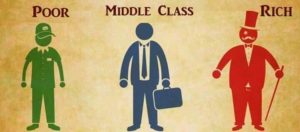IMPORTANCE OF MIDDLE CLASS: FOR INDIA’S ECONOMY AND ITS DEMOCRACY
Relevance: Mains: G.S paper III: Indian Economy &
Sociology: Paper I: Stratification and Mobility: Dimensions – Social stratification of class, status groups, gender, ethnicity and race.
Sociology paper II: Social Structure: Social Classes in India: Agrarian class structure. Industrial class structure. Middle classes in India.
\

Context:
India’s Economy 2021: In 2020, Covid disruption resulted in reducing India’s vibrant middle class by one-third.
Why in news?
There are two main reasons why the novel Coronavirus has been such a disaster for the world economy:
One, that it infects everyone — regardless of their economic status, and
two, because it essentially spreads just the way economic growth does — via human interaction. In other words, controlling the virus’ spread and limiting the damage on the health side necessarily, by definition, results in incurring economic losses.
While this was known from day one, this odious trade-off explains why so many governments and populations have been caught napping with more damaging second and third waves.
India is no exception. But, unlike other countries such as China, which controlled the virus much sooner, or the US and the UK, which despite being hit hard by Covid had the financial resources to protect the livelihoods of their people, India has suffered grievously.
- The massive and unabated surge in Covid cases all across the country, which has exposed the government’s lack of preparation over the past year as grossly inadequate, points to the possibility of a scenario where India may not even be able to make up for the economic (GDP) contraction it suffered in the last financial year (2020-21).
But what does it mean in real terms?
- Such a sharp contraction in GDP growth essentially means that millions of people will not only lose part or all of their current incomes but also the means to earn their income.
- What’s worse, since India’s economy was already decelerating before the pandemic, people do not have the savings to fight for long. Sooner rather than later they will see a sharp worsening in their economic, physical and social wellbeing.
- A lot of focus has been on the pitiable state of India’s migrant workforce, but there is an equally primal shriek of desperation being let out by India’s middle class — one which has largely gone unheard.
- “Prior to the pandemic, it was anticipated that 99 million people in India would belong in the global middle class in 2020.
- A year into the pandemic, this number is estimated to be 66 million, cut by a third. Meanwhile, the number of poor in India is projected to have reached 134 million, more than double the 59 million expected prior to the recession,” stated the Pew report.
- While the fact that 75 million people will be pushed back to abject levels of poverty (of living at less than $2 a day), what is equally, if not more, worrisome is that fact that India’s middle class was reduced by one-third — and that is just the impact of the last year.
- Given its severity, the current second wave and its economic impact could well mean that India’s middle class will be reduced to half of what it was before the pandemic.
What exactly is the middle class?
- Typically economic researchers tend to use income or expenditure (as a proxy for income) to spot the middle class.
- For instance, in the above case, the poor live on $2 or less daily, low income on $2.01-$10, middle income on $10.01-$20, upper-middle income on $20.01-$50 and high income on more than $50.
- But it is possible to define the middle class as those whose expenditure ranges between 75% to 125% of the median expenditures.
Further, cash is not the only marker of being middle class.
- It is also characterised by certain values, mindsets, educational and occupational choices.
- For instance, people belonging to the middle-class aim to have decent well-paying jobs or small businesses, hope to own a house of their own, seek to have a secure retirement, and want to secure the healthcare and educational needs of their family.
- Every generation of a middle-class household hopes that its next-generation would be slightly better off.
Why does the middle-class matter?
- Unlike its humble name, the middle class is often considered the glue that keeps modern liberal democratic economies from falling apart under the strain of ever-rising inequalities.
- “What Karl Marx saw as an inevitable revolution was based on the assumption that the economy would eventually generate a bipolar income distribution composed of rich and poor.
- Once this bipolar situation existed, he said, the poor would revolt, destroy the rich, and establish communism.
- But Marx’s predicted revolution did not occur because he did not foresee the rise of the middle class.
- The middle class had an interest in preserving capitalism and voted to alleviate the worst excesses of capitalism with social welfare programs.
- Their very presence gave the poor hope that they too could escape from poverty,” he wrote.

